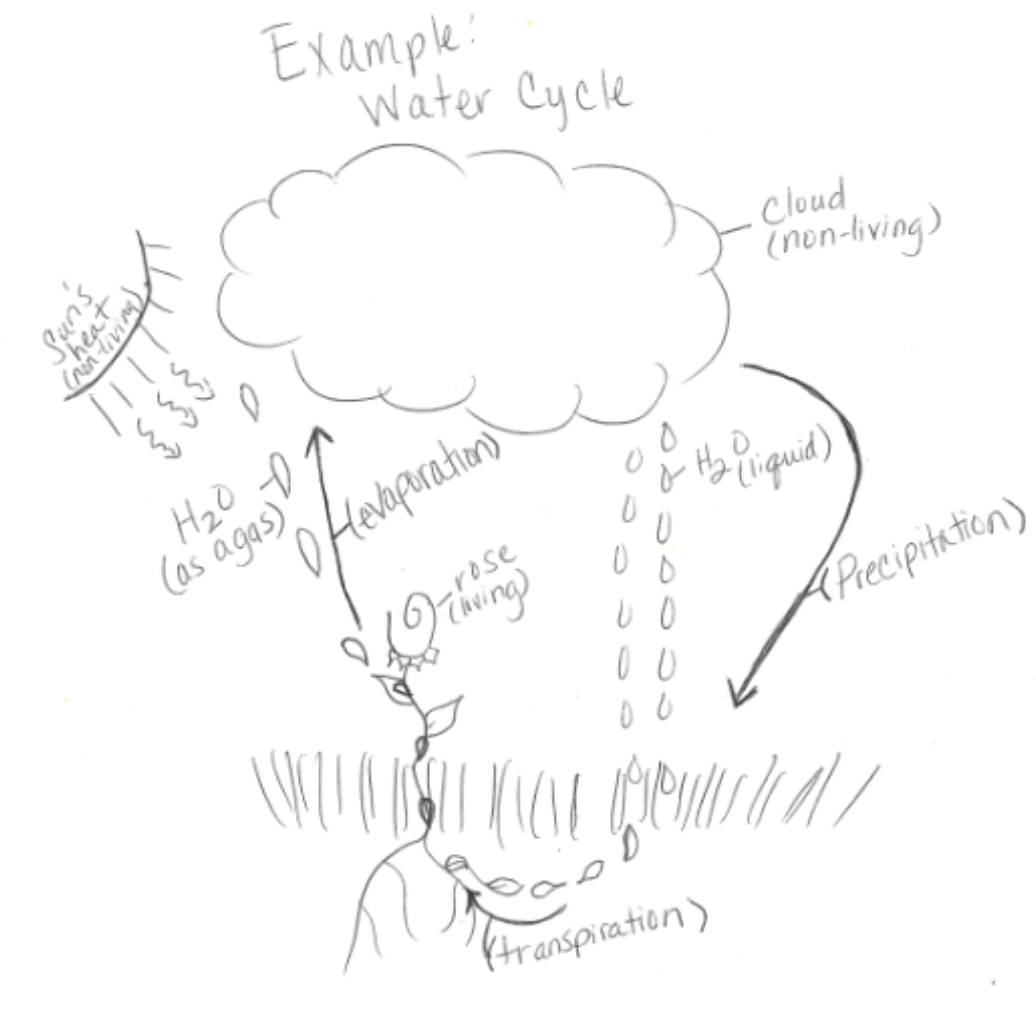Summary
In this lesson, students will learn about the different stages in which a rock can exist due to natural causes or human impact. Students will construct models that illustrate how biochemical processes cycle through living and nonliving organisms.
Essential Question(s)
How do Earth’s materials cycle through living and nonliving components?
Snapshot
Engage
Students justify and evaluate preconceived notions about rocks, and watch a clip of a natural disaster caused by rock transformation.
Explore
Students investigate different stresses that affect rock formation.
Explain
Students read an article to help construct explanations for the flow of the rock cycle.
Extend
Students research and create a model that shows the flow of different matter into and out of living and nonliving parts of the ecosystem.
Evaluate
Students assess and gather data from one another's work and use the information to answer the lesson’s essential question.
Materials
Lesson Slides (attached)
You’re Stressing Me Out Lab Instructions (attached; one per student)
You’re Stressing Me Out Lab handout (attached; one per student)
Minerals, Rocks, and the Rock Cycle handout (attached; one per student)
Rock Cycle handout (attached; one per student)
Biogeochemical Cycles handout (attached; one per student)
Careers Card Sort (attached; one per student)
Careers Card Sort Solution (attached)
Internet-capable devices
Career Reflection handout (attached; one half-page per student)
Regular-size bars of Ivory soap (one per student)
Copy paper (one sheet per group of three students)
Glue sticks (one per group)
Colored chalk (one set per group)
Butcher paper (optional; one sheet per group)
Markers (optional; one set per group)
Highlighters (one per student)
Scissors (one pair per group)
Engage
20 Minute(s)
Use the attached Lesson Slides to follow along with the lesson. Display slide 3 and read aloud the essential question:
How do Earth’s materials cycle through living and nonliving components?
Display slide 4 and share the learning objectives.
Display slide 5. Invite students to participate in an Always, Sometimes or Never True activity. As you go through each statement on slides 6–13, have students give a thumbs up for always, thumbs to the side for sometimes, or thumbs down for never. Be sure to read each statement separately and call on different students to give their opinions on the statement.
All rocks are hard.
Rocks can change form.
Rocks make up the entire Earth.
All rocks are the same.
It’s hard to tell how rocks originated.
Rocks and minerals are the same thing.
Humans are the cause of rock formations.
Minerals are not important to my life.
After wrapping up the Always, Sometimes, or Never True activity, show one or both video clips about sinkholes that have occurred in Oklahoma.
Clip 1 (slide 14): “Massive Oklahoma Sinkhole appears overnight”
Clip 2 (slide 15): “Weatherford building about to be swallowed by sinkhole”
Write down any questions that students have after watching the clips.
Explore
20 Minute(s)
Before beginning this portion of the lesson, gather the supplies for the lab.
Move to slide 16 and distribute the You’re Stressing Me Out Lab Instructions (attached) and the You’re Stressing Me Out Lab handout (attached). Read the introduction aloud as a class to review the three types of stresses that the students will perform.
Move students into groups of three and give each group a bar of soap. Instruct students that each group member will demonstrate one of the three types of stressors. Before each demonstration, ask students how they can go about showing this particular stressor. After each demonstration, have students record their observations on their lab handouts. Move around the room to monitor students and clear up any potential misconceptions.
At the end of the activity, have students use compressional stress to take the small soap remains that they have left and smash them together. Tell students that this is how sedimentary rocks are formed.
Explain
40 Minute(s)
Display slide 17 and distribute the Minerals, Rocks, and the Rock Cycle handout (attached) and highlighters. Instruct students to read the article. As they read, direct students to highlight information about the rock cycle they deem to be important.
Move to slide 18 and organize students into new groups of three. Invite students to complete the Rock Cycle handout (attached). Provide each group with one blank sheet of copy paper and a glue stick. Direct students to divide the three stages (igneous, sedimentary or metamorphic) of the rock amongst their group. Have students follow the directions on the handout to select and illustrate a type of rock that exists at their chosen stage and explain which processes must have occurred for the rock to be at that stage.
After each student has completed their section, have the group place their sections in the correct order of the rock cycle in a cyclical formation. Ask them to label each component of the cycle and draw arrows showing the direction in which it moves.
Extend
60 Minute(s)
Distribute the Biogeochemical Cycles handout (attached). Organize students into groups of four. Go to slide 21 and inform students they will learn about other essential materials that living and nonliving factors cycle through the environment. Assign each group one of the cycles listed below.
Biogeochemical Cycles:
water
carbon
nitrogen
Invite students to research facts about at least three different stages of each cycle and what drives the movement to each part of the cycle. Make sure students cite where they are getting the information about the biogeochemical cycles. Emphasize the importance of students working together to research and delegate tasks for illustrating the cycle. Since this activity moves outside, be sure to constantly circle and monitor the students’ progress.
Next, escort students outside, provide them with a set of colored chalk, and invite each group to draw their cycles on the pavement.

Evaluate
15 Minute(s)
Move to slide 24 and direct students to the second page of the Biogeochemical Cycles handout. Invite students to do a Gallery Walk to view the other groups’ cycles. Ask them to gather data on the stages each group chose to illustrate and take notes on their Biogeochemical Cycles handouts. They should then evaluate this data and use the findings to draft an answer to the essential question (displayed again on slide 25):
How do Earth’s materials cycle through living and nonliving components?
Remind students to use vocabulary that they learned in this lesson to respond to the essential question.
Resources
Emily B. (2012, October 29). WE WILL ROCK YOU! (The rock cycle) [Video]. YouTube. https://www.youtube.com/watch?v=r68iEwYdbh4
Generation Genius. (2020, August 31). Read about rocks, minerals & the rock cycle: Science for grades 6–8. https://www.generationgenius.com/rocks-and-minerals-reading-material-grades-6-8/
K20 Center. (n.d.). Always, sometimes, or never true. Strategies. https://learn.k20center.ou.edu/strategy/145
K20 Center. (n.d.). Card sort. Strategies. https://learn.k20center.ou.edu/strategy/147
K20 Center. (n.d.). Gallery walk / carousel. Strategies. https://learn.k20center.ou.edu/strategy/118
K20 Center. (n.d.). R.E.R.U.N. Strategies. https://learn.k20center.ou.edu/strategy/819
Khan Academy. (n.d.). Intro to biogeochemical cycles. https://www.khanacademy.org/science/biology/ecology/biogeochemical-cycles/a/introduction-to-biogeochemical-cycles
KOCO TV. (2015, June 05). Weatherford building about to be swallowed by sinkhole [Video]. YouTube. https://www.youtube.com/watch?v=HCUthn8Z_KY
NBCUniversal News Group.
(2016, December 5). NBC News - Breaking News & Top Stories - Latest World, US & Local News [Online image]. http://media4.s-nbcnews.com/j/newscms/2016_49/1821236/sink_hole_ea406342d04bed2983c95f1e3f461e53.nbcnews-fp-400-280.jpg
ParrMr. (2011, April 3). Rock cycle song [Video]. YouTube. https://www.youtube.com/watch?v=53lMdHzvGCQ
Regents of the University of Colorado. (2006). Soapy stress activity. TeachEngineering. https://www.teachengineering.org/activities/view/cub_rock_lesson01_activity1
Sister Christian. (2011, November 30). Massive Oklahoma Sinkhole appears overnight [Video]. YouTube. https://www.youtube.com/watch?v=Pz6EFS1fu1A
Soft Schools. (n.d.). The rock cycle. https://softschools.com/language_arts/reading_comprehension/science/493/the_rock_cycle/


